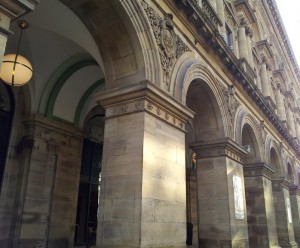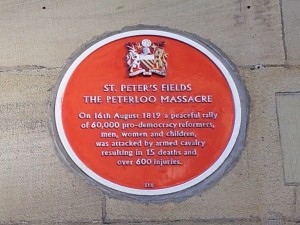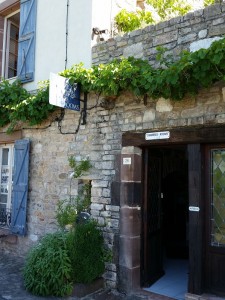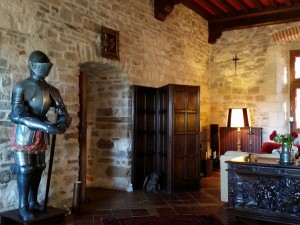
Last weekend, taking a break from romantic sagas and all things Basque, we headed off to the village of St Antonin Noble Val in the neighbouring department of the Tarn-et-Garonne. Though a mere hour’s drive away, the countryside soon began to change, the hilltop villages and high plateaux reminding us we were approaching the towering limestone cliffs of the gorges de l’Aveyron.
A quick read of the local history before setting off brought to mind Montaigne’s gloomy pronouncement that ‘of all the animals in the world, man is the most fearsome’. In the 13th century the village of Saint Antonin was a Cathar stronghold, earning the wrath of the Holy Roman Church and its crusading army (The Albigensian Crusade), including a sack of the town by the troops of the devil himself, Simon de Montfort. You can read more about him here including his well-deserved demise in 1218 at the hands, it is rumoured, of an early feminist from Toulouse who launched a rock at his head from the roof of Saint-Sernin.
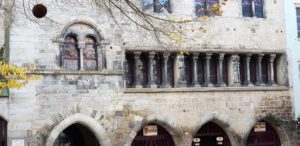
In the 14th century the village was fought over at length by the two opposing sides in the Hundred Years’ War (1337-1453, House of Plantagenet v House of Valois), then, after a bit of a breather in the 15th century, things turned nasty once more when the Wars of Religion (1562-1598) broke out and the village became a bastion of Protestantism. A massacre of Protestants by Catholics in 1561 was followed by a massacre of Catholics by Protestants in 1568. (Everybody following? Good. Nearly finished.)
King Louis XIII intervened in 1621 (he had come to lay siege to the neighbouring town of Montauban) destroying the village walls and re-baptising the place Saint Antonin Noble Val.
There was a happy codicil to this page of horrors in 2014, when the village was chosen as the setting for a rom-com starring Helen Mirren and Om Puri The 100-Foot Journey.* ‘It behoveth man more to make love not war,’ as I’m sure the Mighty Michel would have written if he’d been around to comment.
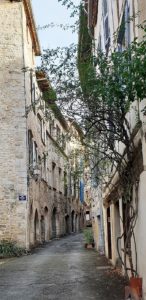
The village layout has remained authentically medieval as we soon realised when stupidly following the satnav into the narrow streets leading to our chambre d’hôtes. We were forced to a halt three times, unsure whether it was possible to continue further without leaving a couple of Peugeot wing mirrors embedded in priceless ancient monuments, finally helped by a kind local who, we later discovered, was the baker, and who relayed to our hosts the news of our impending arrival long before we’d scraped through the labyrinth and managed to find a parking place safely outside the ancient centre.
Having abandoned the car, we found ourselves in Kodak heaven.

But before indulging in a point and click fest, we checked in at our lodgings, the Auberge Lion d’Or, an 18th century coaching inn whose sign advertises ‘Un bon logis à pied ou à cheval’–‘a good lodging whether on foot or on horseback’, words which held a particular resonance for us. (Next time, remember to bring Dobbin). Since January this year the establishment has been run by the felicitously named Mr and Mrs Shakeshaft (no I’m not making it up), more commonly known as Renée and Paul, whose hostly qualities have evidently contributed hugely to the establishment’s success.
The inside is as atmospheric as the outside, but though the beams may be black with age and the stones ancient, the beds are 21st century comfortable, the bathrooms are en suite, and on this wet and chilly November evening, a black stove resembling a lion couchant roared away in the comfortable salon topping up the blissfully warm under-floor heating.

We decided to leave our explorations until the next day (hopefully sunny) and, on the recommendation of our hosts, sallied forth to dine at Le Carrée des Gourmets. The Muse, obviously miffed at being abandoned, decided to give a nudge: the restaurant was decorated with strings of Espelette peppers and the wine list featured Irouleguy, which naturally we sampled, saying ‘Vive le pays basque’ as we ate an excellent meal of chicken and gambas for me, and sweetbreads in a snail sauce for the Maître de Maison.
Saturday dawned damp and misty, giving us a moody view of the roc d’Anglars from the bedroom window and encouraging us to linger over the copious breakfast during which we discovered, thanks to our host, that some scenes from The 100-Foot Journey had actually been shot in the auberge.
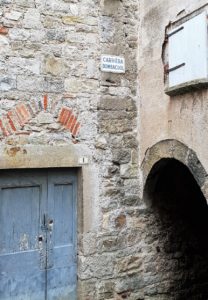
As the weather cleared we set out with map and guide book, starting with the little alley next to the inn, curiously named Carriera Bombacuol, (rue Bombecul in modern French). ‘Stick out ze bottom??’ In spite of our limited knowledge of Occitan we got the message as we teetered down the treacherous slippery slope of Bum-in-the-air Street * in a hunched, waddling, semi-crouch. Later our hostess explained that this was where the horses were taken down to the stables underneath the auberge, the valets doubtless adopting the same inelegant posture as ourselves in order to avoid Bums-on the-cobbles.
From then on it was merveille after merveille in this village out of time where ancient archways invite the visitor to wander into the past through crooked twisting streets. Arriving at the Place de la Halle, the market square, there was a more open vista from which to admire one of the most impressive facades, that of the Maison des Consuls, the old town hall, built in 1125 and reputedly the oldest civic building in France. Restorations were carried out on the tower by Viollet-le-Duc, the man who restored the city of Carcassonne to its former glory and set off lots of architectural arguments.

In Rue Guilhem Peyre, the narrow street which winds down as you step under the tower archway, is the Caserne des Anglais. English troops occupied these barracks in the 13th and 14th centuries, during the Hundred Years’ War and judging by the amount of English we heard, several descendants have since returned, this time however in a spirit of entente cordiale. One of the places I’d hoped to drop in to was The English Bookshop, opened 20 years ago, which I was looking forward to raiding. But like many other commerces it was closed, one disadvantage of an off-season trip here, but offset by the fact that, away from the squares and cafés, we virtually had the town to ourselves.
What a treat. Drinking in the atmosphere of the silent streets with shuttered facades, lingering before buildings with fascinating histories: the Maison du Roy, a gift to King Louis IX, ‘Saint Louis’ as he became after his death, from Guy de Montfort, brother of the infamous Simon, in 1227 and whose first floor has 6 ornately decorated Gothic windows; the Maison de l’Amour (a former brothel?) whose 15th century arcade is surmounted by a carving of a couple exchanging a kiss, peculiar carvings and corbels such as the one showing a naked upside down woman held in the jaws of a lion-like monster.
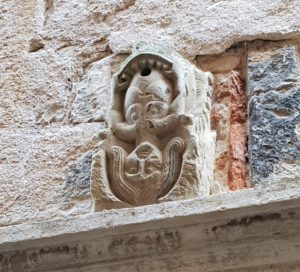
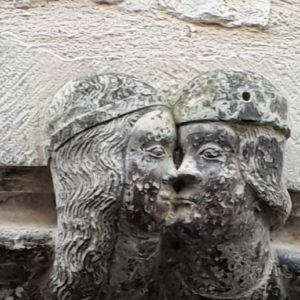
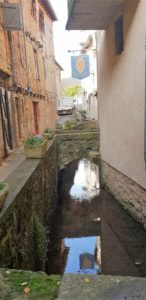
Our wanderings were accompanied by the sound of underground streams rushing beneath grates; occasionally we crossed placid canals. Saint Antonin is a watery town, an important tanning industry flourished here in the 13th century.
Sunday was our last day. We’d been eagerly anticipating exploring the famous weekly market which extends from one edge of the town to the other. But as the rain pelted down with a vengeance, shoes began to squelch and drops began to seep under collars, we finally abandoned the attempt and headed to the car. Hurrying over the cobbles we were halted in our tracks by mouth-watering smells coming from one stall. We ended up returning to The Cowshed with the spoils of our trip into the Middle Ages, half-a dozen freshly baked naan breads and a bag of onion bhajis.
More Om Puri than Simon de Montfort. But we’ll be back to try the saucissons…
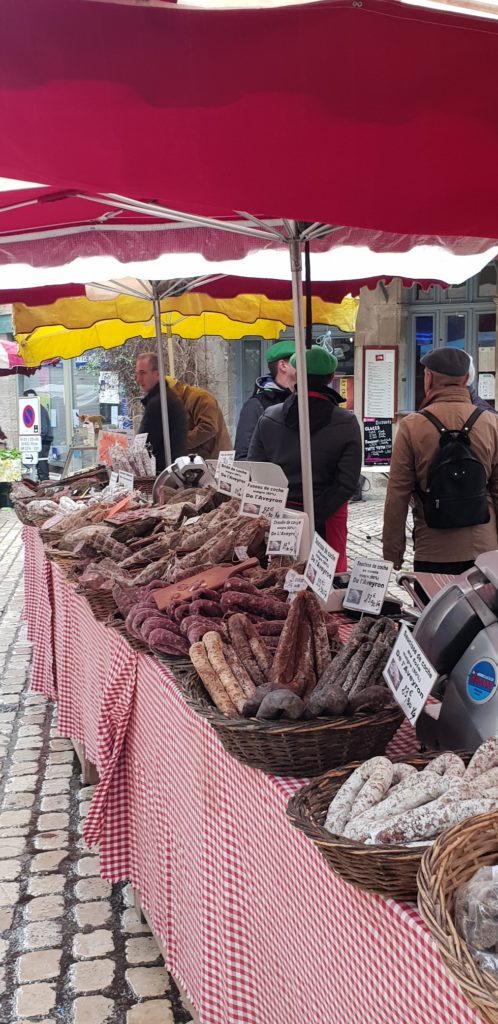
*In 2001 the village also featured in Charlotte Gray, the film adaptation of the book by Sebastian Faulks.
** In French bomber = to stick out cul = arse
PS We ate lunch at a tiny café called Le Citron Bleu, highly recommended!
BEFORE YOU GO….
Bookworms! Hot from the press…Don’t miss Legacy, the latest in the Project Renova series by Terry Tyler and Two Rivers, one Stream, Book 2 of Karma’s Children by John Dolan (more about these authors here)
Also, to make sure you have plenty of books to see you through the Turkey Season, Books 1 and 2 in the French Summer Novels are FREE to download this weekend.
Happy reading!
